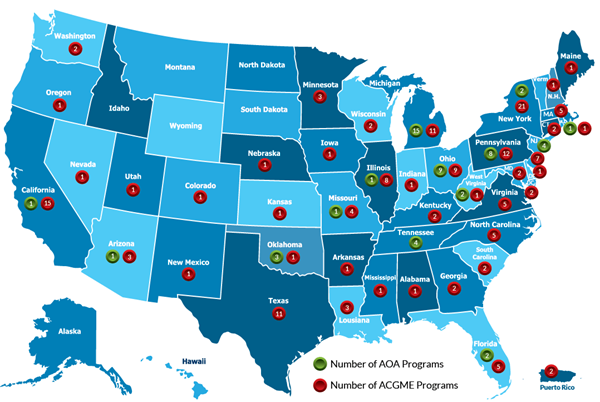The Changing Training Landscape
In February 2014, after months of discussion, the American Osteopathic Association (AOA) and the Accreditation Council for Graduate Medical Education (ACGME), along with the American Association of Colleges of Osteopathic Medicine (AACOM), reached an agreement for a single accreditation system for the graduate medical education (GME) system in the United States.
The Road Ahead
Beginning in 2015, AOA-accredited training programs will have a five-year period to transition to ACGME-accreditation. Programs with an osteopathic focus will continue under the new system and will be open to both DO and MD graduates. Likewise, under the new agreement, allopathic medical school graduates will have access to the traditionally osteopathic training programs.
The single accreditation system will ensure quality, consistent training for all physicians-in-training, and will provide increased access to fellowships for osteopathic trainees.
The single accreditation system will ensure quality, consistent training for all physicians-in-training, and will provide increased access to fellowships for osteopathic trainees. It is not yet clear whether there will be a single match program, although this seems likely. At this point, when it comes to licensure for osteopathic physicians, it seems that COMLEX-USA will not be going anywhere. However, there will likely be opportunities to help program directors better interpret COMLEX scores when considering osteopathic applicants. While a framework has been created, the impact for emergency medicine training will continue to evolve as the AOA and AACOM appoint osteopathic representatives to serve on the ACGME Board and Emergency Medicine Residency Review Committee (RRC).
The Changing Landscape
While some variation from this plan is to be expected, we hope to explain how the transition to a single accreditation system should unfold over the next several years, as well as summarize the options currently available to osteopathic students applying for emergency medicine residency training programs.
As of this month, there are 50 AOA-approved EM residency programs (www.opportunities.osteopathic.org), and 167 ACGME-accredited programs (https://www.ama-assn.org/go/freida). Five programs are dually accredited, bringing the combined number of training programs to 217.
Traditional AOA and Dually Accredited Programs
For students seeking to match into AOA-approved or dually accredited programs, the process is fairly straightforward via the AOA Match. The advantage of dually accredited programs is that graduates receive both AOA and ACGME credit, and have the option to become board certified by either, or both, the AOA and the American Board of Medical Specialties (ABMS). All AOA-approved EM residencies require four years of training, with the first year being considered an internship year.
Rank lists for the AOA match must be finalized by late January and results are released at the beginning of February. On the other hand, the National Residency Matching Program requires rank lists to be submitted by late February, and results are released in late March. Students who successfully match in an AOA program via the National Matching Services (NMS) are not eligible to apply for ACGME programs via the NRMP.
ACGME Programs +/- AOA Internship
Osteopathic students seeking ACGME residency training have a number of options available to them, including the decision of whether or not to complete a traditional AOA intern year prior to applying for an ACGME program. It may be wise for interested students to investigate the “DO friendliness” of programs they are considering. Programs in areas of the country without a strong osteopathic representation, or that have never before accepted osteopathic residents, may not be worth aggressively pursuing. The majority of ACGME programs are three years in length with a handful of programs offering four years of postgraduate training. Some ACGME programs will not take osteopathic applicants who have not completed a traditional AOA-approved intern year, while others accept osteopathic graduates directly from medical school.
Aside from program-specific acceptance requirements, it is also important to keep in mind that without completing a traditional AOA-approved intern year, you will not be able to obtain a permanent license to practice in five states – Michigan, Oklahoma, Pennsylvania, Florida, and West Virginia.
AOA Resolutions 42 and 29
The AOA began approving ACGME training in the 1980s, when the number of osteopathic medical school graduates outnumbered the number of osteopathic GME positions. In 2000, AOA Resolution 42 provided a mechanism for approving an ACGME PGY-1 year as equal to an AOA-approved internship, with certain stipulations.
The applicant must have an AOA membership, complete an application agreeing to the approval process and release of information, must demonstrate osteopathic educational activity (such as AOA conference presentations or attendance), and the PGY-1 rotations have to be similar to the traditional AOA internship. Between 2002 and 2010, more than 2,000 Resolution 42 requests were approved, while only 11 were denied. More recently, in 2010, AOA Resolution 29 allowed for approval of an entire ACGME residency, not just the intern year. By taking advantage of these AOA recognition pathways for ACGME training, trainees are eligible for licensure in all 50 states.



